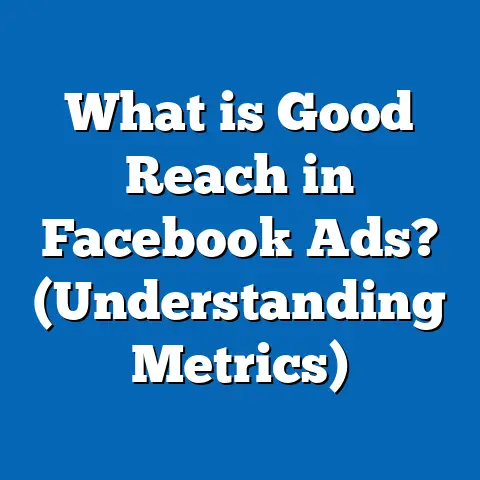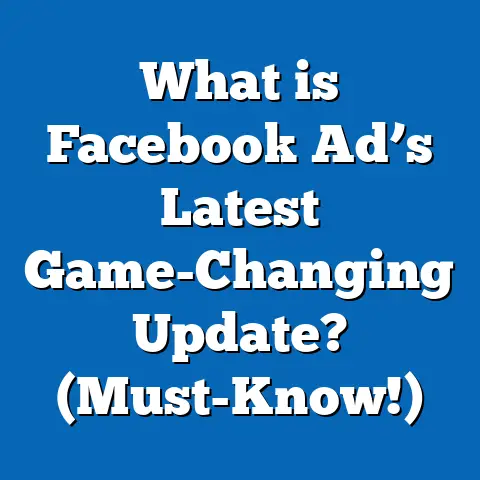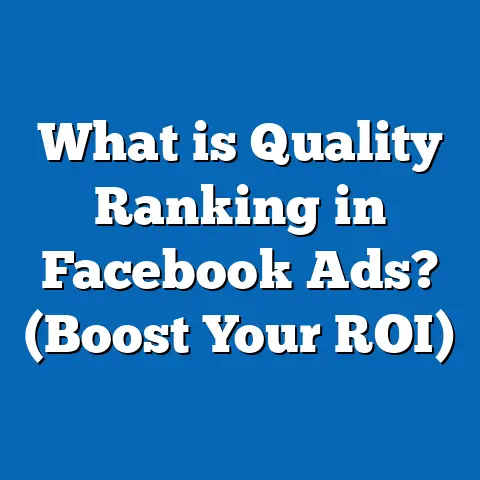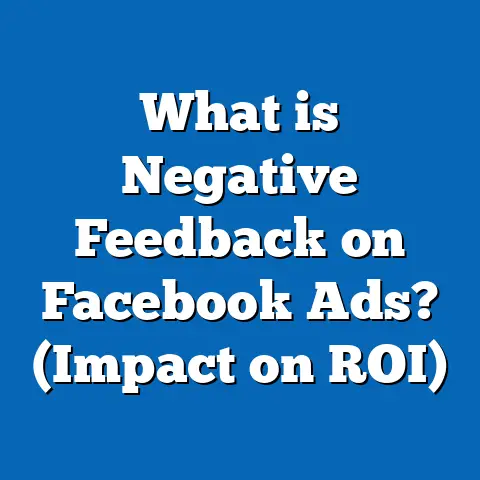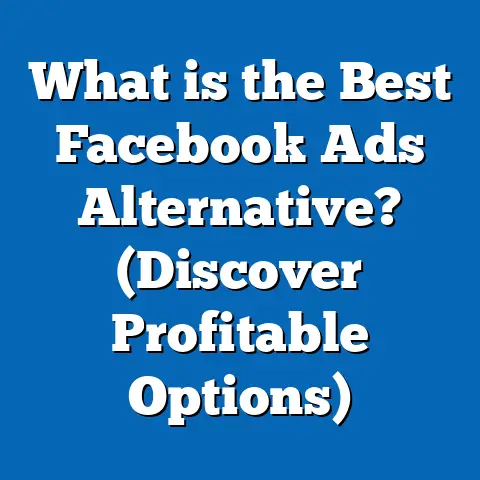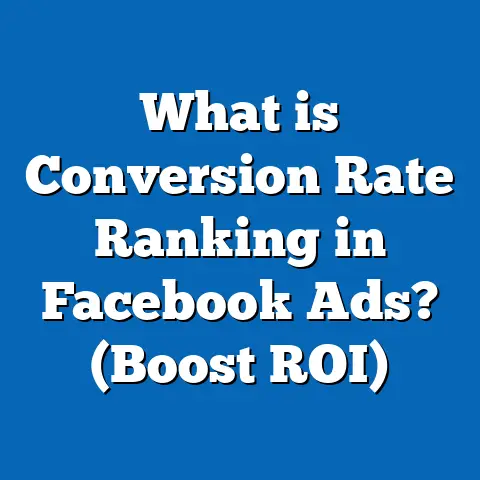What is a Good Cost Per Lead for Facebook Ads? (Find Out!)
What is a Good Cost Per Lead for Facebook Ads? (Find Out!)
Introduction: Navigating the Advertising Ocean
Imagine steering a ship across a vast ocean. The goal is to reach a profitable island, but the waters are dotted with hidden reefs and unpredictable storms. In Facebook advertising, Cost Per Lead (CPL) is your compass—it guides you to efficient spending and better returns. But what exactly is a good CPL, and how do you know if your campaign is sailing smoothly or headed for trouble?
Understanding and optimizing CPL can make the difference between wasting your marketing budget and generating a steady stream of valuable leads. This guide will break down everything you need to know about CPL on Facebook—from basics to advanced strategies—equipping you with actionable insights to master your campaigns.
Understanding Cost Per Lead (CPL)
What is Cost Per Lead?
Cost Per Lead (CPL) represents the average amount spent to acquire one lead through an advertising campaign. In Facebook Ads, a lead might be someone who fills out a form, signs up for a newsletter, or expresses interest in your product or service.
Formula: CPL=Total Ad SpendNumber of Leads Acquired\text{CPL} = \frac{\text{Total Ad Spend}}{\text{Number of Leads Acquired}}
For example, if you spend $500 on Facebook ads and generate 50 leads, your CPL is $10.
Why CPL Matters in Facebook Advertising
CPL is a key metric because it directly ties your advertising costs to potential revenue. A low CPL means you are acquiring leads efficiently, while a high CPL might indicate wasted budget or ineffective targeting.
Facebook’s powerful targeting options allow advertisers to tailor campaigns for specific audiences, but without monitoring CPL, even the best-targeted ads can become costly.
Differentiating CPL from Related Metrics
It’s essential to understand how CPL differs from other common metrics:
- Cost Per Click (CPC): The amount paid each time someone clicks on your ad.
- Cost Per Acquisition (CPA): The cost to acquire a paying customer.
- Return on Ad Spend (ROAS): Revenue generated for every dollar spent on ads.
While CPC measures engagement and CPA focuses on actual customers, CPL targets those who have shown interest but may not yet have purchased. Monitoring CPL helps optimize the top of your sales funnel.
What is Considered a Good Cost Per Lead on Facebook?
Industry Benchmarks and Averages
Determining a “good” CPL depends heavily on your industry, business model, and campaign goals. Here are some average CPL ranges based on recent data from multiple sources including WordStream, AdEspresso, and Facebook Ads reports:
| Industry | Average CPL (USD) |
|---|---|
| B2B Software | $30 – $60 |
| Education | $15 – $35 |
| Real Estate | $20 – $50 |
| Finance & Insurance | $40 – $80 |
| Healthcare | $20 – $40 |
| E-commerce | $5 – $20 |
| Travel & Hospitality | $10 – $25 |
Key Insight:
A good CPL is one that fits within or below your industry’s average range and allows you to maintain a positive return on investment (ROI).
Detailed Breakdown by Industry
B2B Software
B2B companies selling software often face higher CPLs due to the complexity of their offerings and longer sales cycles. Leads must be highly qualified because closing deals can take months.
- Average CPL: $30 – $60
- Why Higher CPL? More extensive nurturing is necessary; leads are typically decision-makers.
- Example: A SaaS company targeting IT managers may spend $50 per lead but sees higher revenue per customer.
Education
Educational institutions and online course providers usually have moderate CPLs, influenced by program costs and enrollment complexity.
- Average CPL: $15 – $35
- Why Moderate? Leads often convert after some research; competition from other institutions affects costs.
- Example: An online MBA program with a CPL of $25 can be profitable if tuition fees are high enough.
Real Estate
Real estate leads tend to be expensive because properties are high-value items, and buyers are selective.
- Average CPL: $20 – $50
- Why? High competition and the need for qualified leads push up costs.
- Example: A real estate agent targeting luxury home buyers may accept a CPL of $45.
Finance & Insurance
Financial services have some of the highest CPLs due to strict regulations and complex product offerings.
- Average CPL: $40 – $80
- Why? Leads must be carefully vetted; compliance adds complexity.
- Example: An insurance firm might pay $70 per lead but benefit from high lifetime customer value.
Healthcare
Healthcare marketers see moderate CPLs. HIPAA regulations impact targeting options.
- Average CPL: $20 – $40
- Why? Sensitive nature of services; trust-building is crucial.
- Example: A dental clinic might pay $30 per lead but convert patients over time.
E-commerce
E-commerce businesses generally have lower CPLs due to quick purchase decisions and broad audiences.
- Average CPL: $5 – $20
- Why? High volume, impulse purchases, and strong retargeting options.
- Example: A fashion retailer might achieve a CPL of $8 with targeted ads.
Travel & Hospitality
Travel industry faces seasonal fluctuations affecting CPL.
- Average CPL: $10 – $25
- Why? Seasonality impacts demand; competitive bidding increases costs during peak times.
- Example: A hotel chain might see lower CPLs off-season and higher during holidays.
Why Industry Averages Don’t Tell the Whole Story
Although averages provide useful guidelines, they don’t guarantee success. Some businesses can afford higher CPLs if their customer lifetime value (CLV) is high. Others need ultra-low CPLs due to tight margins.
Understanding Customer Lifetime Value (CLV)
CLV measures the total revenue expected from a customer over their relationship with your business. If CLV exceeds acquisition costs significantly, higher CPLs can be justified.
Example:
- CLV = $500
- Desired profit margin = 40%
- Max CPL = $500 × (1 – 0.4) = $300
This means spending up to $300 to acquire one lead could still be profitable if conversion rates align.
How Conversion Rates Affect Your Ideal CPL
Conversion rate from lead to customer dramatically impacts what constitutes an acceptable CPL. Max Acceptable CPL=Max Cost per Acquisition×Conversion Rate\text{Max Acceptable CPL} = \text{Max Cost per Acquisition} \times \text{Conversion Rate}
If you know your average cost per acquisition (CPA) target and lead-to-customer conversion rate, you can back-calculate your maximum CPL.
Factors That Influence Your Facebook Ads CPL
1. Target Audience Quality
Precise targeting reduces wasted impressions. Use Facebook’s detailed demographics, interests, behaviors, custom audiences, and lookalikes.
Tip: Exclude irrelevant audiences to avoid spending on low-converting users.
2. Ad Relevance and Creative Quality
Facebook rewards relevant ads with lower costs. Use compelling headlines, clear calls-to-action (CTAs), and attractive visuals or videos.
Data Point: Ads with relevance scores above 8 can reduce costs by up to 30%.
3. Landing Page Experience
Landing pages must load quickly, match ad messaging, and minimize friction (e.g., fewer form fields).
Stat: A 1-second delay in load time can reduce conversions by 7%.
4. Campaign Objective and Optimization
Choosing the right objective (Lead Generation vs Conversions vs Traffic) impacts how Facebook delivers ads.
Lead Generation campaigns optimized for leads generally produce lower CPL than Traffic campaigns focused on clicks.
5. Competition and Seasonality
Higher competition in auctions pushes up bids. Ad costs often spike during holidays or industry-specific peak times.
Case Study: How One SaaS Company Reduced Its CPL by 40%
Background: A B2B SaaS company was spending around $50 per lead, above their target of $30.
Approach:
- Refined audience targeting by excluding irrelevant demographics.
- Tested new ad creatives with clearer value propositions.
- Improved landing page load time and simplified form fields.
- Switched campaign objective from Traffic to Lead Generation optimized for conversions.
Result: Within three months, their average CPL dropped to $30, increasing lead volume by 25% without extra spend.
Deep Dive: Segmenting Your Audience for Lower CPL
Using Custom Audiences
Upload existing customer emails or website visitors to create custom audiences who already have some brand familiarity — these groups tend to convert at lower cost.
Lookalike Audiences Explained
Lookalikes mimic characteristics of your best customers using Facebook’s AI. They expand reach while maintaining relevance.
Result: Lookalike audiences often reduce CPL by 15%–25% compared to cold targeting.
Layering Targeting Options
Combine demographics (age, location) with interests and behaviors for laser-focused targeting. Use negative targeting to exclude unlikely buyers.
Comparing Facebook Ads CPL with Other Platforms
| Platform | Average CPL Range (USD) | Notes |
|---|---|---|
| Facebook Ads | $5 – $80 | Strong targeting; good for B2C and B2B |
| Google Ads | $20 – $100+ | Higher intent leads; often costlier |
| LinkedIn Ads | $30 – $120+ | Best for B2B; expensive but high-quality leads |
| Instagram Ads | Similar to Facebook | Owned by Facebook; visually-driven audience |
| Twitter Ads | $10 – $50 | Good for engagement; less common for direct leads |
Takeaway: Facebook offers competitive CPLs especially for B2C and mid-market B2B when campaigns are optimized properly. LinkedIn commands higher prices due to its B2B focus but often delivers more qualified leads in some sectors like professional services.
How to Calculate and Track Your Facebook Ads CPL Accurately
Step 1: Set Up Proper Conversion Tracking
Implement Facebook Pixel on your website or SDK in your app. Track key actions like form completions or sign-ups as conversion events.
Step 2: Define What Qualifies as a Lead
Standardize what counts as a lead across all channels — e.g., email capture vs phone call vs demo request — so you measure consistently.
Step 3: Monitor Metrics in Facebook Ads Manager
Use the “Cost per Result” metric under your Lead Generation or Conversion campaigns to see real-time CPL data.
Step 4: Use Custom Reports for Deep Analysis
Integrate CRM data with ad spend to analyze lead quality and true cost per qualified lead over time.
Advanced Strategies to Lower Your Facebook Ads CPL
A/B Testing Creatives and Audiences
Systematically test elements like:
- Headlines
- Images/videos
- Ad copy length
- CTA buttons
- Audience segments
Keep detailed records of results; small improvements compound over time.
Use Lookalike Audiences Based on High-Value Customers
Create lookalikes not just from all customers but from those with highest lifetime value or engagement.
Retarget Warm Audiences
Set retargeting campaigns aimed at users who engaged but didn’t convert initially. These leads often convert faster at lower cost.
Optimize Ad Scheduling
Analyze when your audience is most active and schedule ads accordingly. Avoid spending during low engagement periods.
Practical Examples of Good CPL Across Different Business Models
- E-commerce: A fashion brand might find a good CPL around $7-$15 because they convert fast online.
- B2B SaaS: A software company selling enterprise solutions could accept a CPL of $40-$60 due to higher deal sizes.
- Local Services: A plumbing company might target a CPL of $15-$30 depending on service value.
- Education: An online course provider may aim for a CPL near $20-$35 depending on course price.
Latest Trends Impacting CPL on Facebook
AI-Powered Optimization
Facebook’s machine learning optimizes delivery toward users most likely to convert based on historical data, reducing wasteful spend.
Privacy Changes (iOS 14+)
Apple’s App Tracking Transparency affected user data availability, causing some advertisers to see increased CPL due to less precise targeting.
Tip: Use Facebook’s Aggregated Event Measurement for better tracking under privacy constraints.
Video Ads Dominance
Video ads generate higher engagement rates than static images; well-crafted videos can lower your average CPL by attracting more qualified attention.
Common Mistakes That Increase Your Cost Per Lead on Facebook
- Poor Targeting: Broad audiences without proper filters lead to wasted impressions.
- Ignoring Ad Fatigue: Running the same creative too long reduces effectiveness and raises costs.
- Neglecting Landing Page Optimization: If users click but don’t convert due to poor UX or slow load times, costs soar.
- Not Testing Enough: Without testing different variables, suboptimal ads remain in place.
- Choosing Wrong Campaign Objective: Selecting Traffic instead of Lead Generation when collecting leads wastes budget on clicks rather than conversions.
Tools & Resources for Managing and Optimizing Your Facebook Ads
- Facebook Ads Manager: Core tool for creating, managing, and analyzing campaigns.
- Facebook Analytics & Insights: For deeper understanding of audience behavior.
- Google Analytics: To complement tracking and analyze post-click behavior.
- Landing Page Builders (e.g., Unbounce, Leadpages): For rapid testing of conversion-focused pages.
- CRM Integration (e.g., HubSpot, Salesforce): To track lead quality beyond ad platforms.
How To Set Realistic Goals for Your Facebook Ads Campaigns
Step 1: Understand Your Funnel Metrics
Know your website traffic, conversion rates from visitor to lead, and from lead to customer.
Step 2: Benchmark Against Industry Standards
Use published data but adjust based on your historical campaign performance if available.
Step 3: Calculate Expected ROI Based on Different CPL Scenarios
Model financial outcomes based on varying lead costs and conversion rates before launching campaigns.
Step-by-Step Checklist for Reducing Your Facebook Ads Cost Per Lead
- Define clear lead criteria aligned with business goals.
- Set up reliable tracking with Pixel/SDK.
- Research industry benchmarks relevant to your niche.
- Create highly targeted custom/lookalike audiences.
- Develop compelling ad creatives tailored for each audience segment.
- Design optimized landing pages that match ad messaging.
- Run A/B tests regularly on creatives and targeting.
- Monitor performance daily; pause underperforming ads.
- Use retargeting campaigns for warm audiences.
- Adjust budgets based on campaign performance trends.
- Stay updated with platform changes affecting ad delivery.
- Analyze CRM data for lead quality feedback loops.
Conclusion: Navigating Toward Profitable Leads with Confidence
Mastering your Facebook ads’ Cost Per Lead is like mastering navigation at sea—once you understand the currents, winds, and tools available, you can steer confidently towards profitable growth. Keep measuring, adjusting, and optimizing to keep your campaigns on course.
Remember:
- There is no one-size-fits-all “good” CPL; it depends on your business context.
- Focus on quality leads that convert into paying customers.
- Use data continuously for informed decision-making.
- Embrace testing as an ongoing process.
- Adapt your approach as platforms evolve with privacy regulations and technological advances.
With these strategies in hand, you’ll be well-equipped to manage efficient Facebook advertising campaigns that deliver valuable leads without breaking the bank.

